1. Atomic structure of sensitive battery materials and interfaces revealed by cryo-electron microscopy standard transmission electron microscopy studies can not maintain chemical reactivity and electron beam sensitive battery materials after operation The original chemical reaction state, such materials can maintain their original state under low temperature conditions. Now, it has become possible to achieve atomic-level resolution of a single lithium metal atom and its interface using a solid electrolyte membrane (SEI). Li et al. found that in carbonate electrolytes, dendrites preferentially grow into single crystal nanowires with clear crystal faces along the <111>, <110> or <211> direction, with the highest priority in the <111> direction. Growing. In the case of kink, these growth directions may change without significant crystal defects. In addition, Li et al. also disclose nanostructures of different SEIs formed in different electrolytes. (Science DOI: 10.1126/science.aam6014) 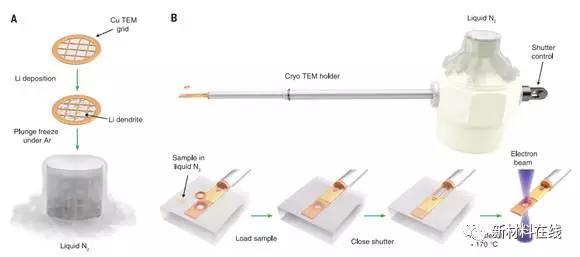 2. Tunable porous nanoallotropes prepared by post-assembly etching of binary nanoparticle superlattices. There are hundreds of different colloidal crystals that can be used. Nanoparticles are prepared by self-assembly, but are almost always limited to having to be densely packed. Udayabhaskararao demonstrates that non-closely packed arrays of nanoparticles can be fabricated by selectively removing one of the two components that make up the binary nanoparticle superlattice. First, a variety of binary nanoparticle superlattices were prepared at the liquid-air interface, including several previously unknown. Molecular dynamics simulations reveal the special role of liquids in the formation of superlattices in the template. Superlattices cannot be achieved by self-assembly in bulk solutions. Second, after stabilization, all of these binary superlattices can be converted into nanoporous materials that have the same chemical composition but differ from their nanoscale structures, ie, "nano allotropes." (Science DOI: 10.1126/science.aan6046)
2. Tunable porous nanoallotropes prepared by post-assembly etching of binary nanoparticle superlattices. There are hundreds of different colloidal crystals that can be used. Nanoparticles are prepared by self-assembly, but are almost always limited to having to be densely packed. Udayabhaskararao demonstrates that non-closely packed arrays of nanoparticles can be fabricated by selectively removing one of the two components that make up the binary nanoparticle superlattice. First, a variety of binary nanoparticle superlattices were prepared at the liquid-air interface, including several previously unknown. Molecular dynamics simulations reveal the special role of liquids in the formation of superlattices in the template. Superlattices cannot be achieved by self-assembly in bulk solutions. Second, after stabilization, all of these binary superlattices can be converted into nanoporous materials that have the same chemical composition but differ from their nanoscale structures, ie, "nano allotropes." (Science DOI: 10.1126/science.aan6046) 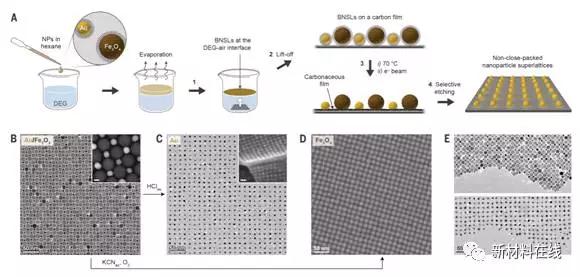 3. Size effects in ion transport through angstrom-scale slits. In the field of nanofluids, it is a far cry to controllably produce capillaries close to the size of small ions and water molecules. final goal. Esfandiar et al. describe ion transport through extremely narrow slits that are fabricated by effectively removing monoatomic planes from bulk crystals. This atomic-scale flat angstrom gap exhibits a very low surface charge and can be explained by the steric effect. Esfandiar et al. also found that ions with a hydration diameter larger than the slit size are still permeable despite the reduced fluidity. The limitation of the slit also allows a comparable size of anion and cation to exhibit a significantly asymmetric migration rate in the channel. This research provides a platform for studying the Ei-scale constraint effects necessary for the development of nanofluids, molecular separations, and other nanotechnology. (Science DOI: 10.1126/science.aan5275)
3. Size effects in ion transport through angstrom-scale slits. In the field of nanofluids, it is a far cry to controllably produce capillaries close to the size of small ions and water molecules. final goal. Esfandiar et al. describe ion transport through extremely narrow slits that are fabricated by effectively removing monoatomic planes from bulk crystals. This atomic-scale flat angstrom gap exhibits a very low surface charge and can be explained by the steric effect. Esfandiar et al. also found that ions with a hydration diameter larger than the slit size are still permeable despite the reduced fluidity. The limitation of the slit also allows a comparable size of anion and cation to exhibit a significantly asymmetric migration rate in the channel. This research provides a platform for studying the Ei-scale constraint effects necessary for the development of nanofluids, molecular separations, and other nanotechnology. (Science DOI: 10.1126/science.aan5275) 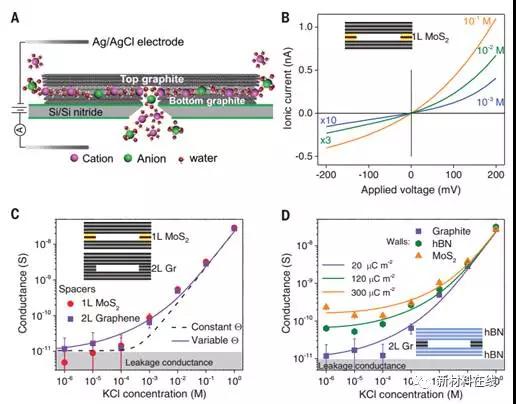 4. One of the current challenges of photonics based on MoTe2-based light-emitting diodes and photodetectors for silicon photonic integrated circuits is the development of high-speed, high-power, chip-integrated optical communication devices. To solve the interconnection bottleneck in high-speed computing systems. Silicon photonics has emerged as the leading architecture, in part because many components such as waveguides, couplers, interferometers, and modulators can be directly integrated into silicon-based processors. However, light sources and photodetectors are facing challenges. Common methods for use as light sources include one or several off-chip or wafer-bonded lasers based on Group III-V materials, but recent system architecture studies have shown the advantage of using multiple directly modulated sources at the emitter location. The most advanced photodetectors in the silicon photonics process are based on germanium, but this requires additional growth of germanium, which increases system cost. The emerging two-dimensional transition metal disulfide (TMD) provides a way for optical interconnect devices to be integrated with silicon photonics and complementary metal oxide semiconductors (CMOS) through back-end processing. Bie et al. demonstrated a silicon waveguide integrated source and photodetector (TMD semiconductor with infrared band) based on a two-layer MoTe2-doped pn junction. This state-of-the-art manufacturing technology offers new opportunities for integrated photovoltaic systems. (Nature Nanotechnology DOI: 10.1038/NNANO.2017.209)
4. One of the current challenges of photonics based on MoTe2-based light-emitting diodes and photodetectors for silicon photonic integrated circuits is the development of high-speed, high-power, chip-integrated optical communication devices. To solve the interconnection bottleneck in high-speed computing systems. Silicon photonics has emerged as the leading architecture, in part because many components such as waveguides, couplers, interferometers, and modulators can be directly integrated into silicon-based processors. However, light sources and photodetectors are facing challenges. Common methods for use as light sources include one or several off-chip or wafer-bonded lasers based on Group III-V materials, but recent system architecture studies have shown the advantage of using multiple directly modulated sources at the emitter location. The most advanced photodetectors in the silicon photonics process are based on germanium, but this requires additional growth of germanium, which increases system cost. The emerging two-dimensional transition metal disulfide (TMD) provides a way for optical interconnect devices to be integrated with silicon photonics and complementary metal oxide semiconductors (CMOS) through back-end processing. Bie et al. demonstrated a silicon waveguide integrated source and photodetector (TMD semiconductor with infrared band) based on a two-layer MoTe2-doped pn junction. This state-of-the-art manufacturing technology offers new opportunities for integrated photovoltaic systems. (Nature Nanotechnology DOI: 10.1038/NNANO.2017.209) 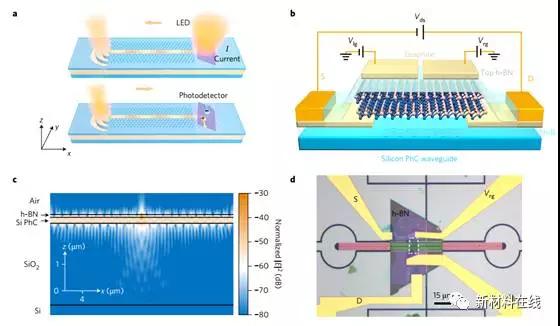
5. Toughening elastomers using mussel-inspired iron-catechol complexes often exhibit a compromise between stiffness and ductility; for example, by increasing Its crosslink density to enhance the elastomer leads to embrittlement and reduced toughness. Inspired by the marine mussels byssi epidermis, Filippidi et al. circumvent this inherent trade-off by linking sacrificial reversible iron-catechol crosslinks to a dry, loosely crosslinked epoxy network. The stiffness, tensile strength and tensile toughness of the iron-containing network are increased by two to three orders of magnitude compared to their iron-free precursors, while achieving recoverable hysteresis energy dissipation and maintaining their original scalability. The drying properties of the iron-containing network itself result in improved performance compared to previous chemical experiments in hydrogels, mainly due to the enhanced crosslink density provided by the reversible iron-catechol complexes and their formation. The synergistic effect of the ionomer clusters of the chain is restricted. (Science DOI: 10.1126/science.aao0350)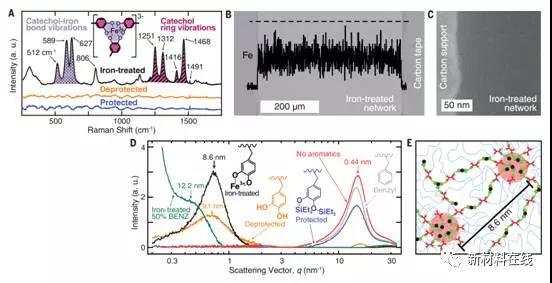 6. Topological states of condensed matter The topological state of quantum matter has been studied intensively in materials science and condensed matter physics in recent years. The explosive development of this field is largely due to accurate theoretical predictions, enabling well-controlled material processing and emerging characterization techniques. In this Perspective article, Wang et al. reviewed recent advances in topological insulators, quantum anomalous Hall effects, chiral topological superconductors, spiral topological superconductors, and Weyl semimetals. (Nature Materials DOI: 10.1038/NMAT5012)
6. Topological states of condensed matter The topological state of quantum matter has been studied intensively in materials science and condensed matter physics in recent years. The explosive development of this field is largely due to accurate theoretical predictions, enabling well-controlled material processing and emerging characterization techniques. In this Perspective article, Wang et al. reviewed recent advances in topological insulators, quantum anomalous Hall effects, chiral topological superconductors, spiral topological superconductors, and Weyl semimetals. (Nature Materials DOI: 10.1038/NMAT5012) 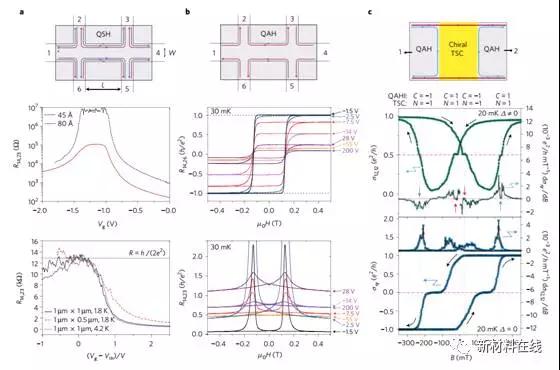 7. Towards properties on demand in quantum materials Over the past decade, the explosive growth in the field of quantum materials has been strongly predicted and discovered by the novel symmetry breaking phase in related electronic systems. Topological phase in a system of rotating orbital coupling, and a super-steerable material platform based on two-dimensional van der Waals crystals. It is found that the way to realize the quantum phase of matter and control its properties through experiments is the core goal of modern condensed matter physics. To achieve this goal, it is hopeful to realize a new generation of electronic/photonic devices that cannot be realized at present and may not be able to imagine its function. In this review, Basov et al. describe an emerging strategy for selectively perturbing microscopic interaction parameters that can be used to transform materials into desired quantum states. The following discussion focuses on the recent success of customizing electronic interaction parameters through the use of strong fields, pulsed electromagnetic stimulation, and nanostructure engineering or interface engineering. Together, these methods outline a potential roadmap for the age of quantum phenomena. (Nature Materials DOI: 10.1038/NMAT5017)
7. Towards properties on demand in quantum materials Over the past decade, the explosive growth in the field of quantum materials has been strongly predicted and discovered by the novel symmetry breaking phase in related electronic systems. Topological phase in a system of rotating orbital coupling, and a super-steerable material platform based on two-dimensional van der Waals crystals. It is found that the way to realize the quantum phase of matter and control its properties through experiments is the core goal of modern condensed matter physics. To achieve this goal, it is hopeful to realize a new generation of electronic/photonic devices that cannot be realized at present and may not be able to imagine its function. In this review, Basov et al. describe an emerging strategy for selectively perturbing microscopic interaction parameters that can be used to transform materials into desired quantum states. The following discussion focuses on the recent success of customizing electronic interaction parameters through the use of strong fields, pulsed electromagnetic stimulation, and nanostructure engineering or interface engineering. Together, these methods outline a potential roadmap for the age of quantum phenomena. (Nature Materials DOI: 10.1038/NMAT5017) 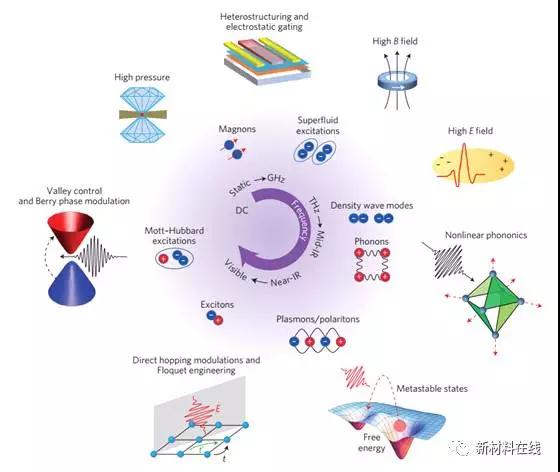 8. Self-assembly of polyhedral metal-organic framework particles into three-dimensional ordered superstructures. Self-assembly of particles into a city, three-dimensional, ordered superstructure for design Materials (including plasma sensing materials, energy or gas storage systems, catalysts, and photonic crystals) are critical. Avci et al., based on experimental and simulation data, show that the metal-organic framework (MOF) ZIF-8 truncated rhombohedral dodecahedral particles can self-assemble into millimeter-sized superstructures with a basic three-dimensional diamond lattice that behaves as a photonic crystal. . These superstructures have a photonic band gap that can be adjusted by controlling the size of the ZIF-8 particles, or the guest material adsorbed in the micropores. Alternatively, superstructures with different crystal lattices can be assembled by adjusting the degree of truncation of ZIF-8 nanoparticles or using octahedral Uio-66 MOF particles. These ordered sub-micron sized superstructure materials may ultimately contribute to the design of three-dimensional photonic materials for sensing applications. (Nature Chemistry DOI: 10.1038/NCHEM.2875)
8. Self-assembly of polyhedral metal-organic framework particles into three-dimensional ordered superstructures. Self-assembly of particles into a city, three-dimensional, ordered superstructure for design Materials (including plasma sensing materials, energy or gas storage systems, catalysts, and photonic crystals) are critical. Avci et al., based on experimental and simulation data, show that the metal-organic framework (MOF) ZIF-8 truncated rhombohedral dodecahedral particles can self-assemble into millimeter-sized superstructures with a basic three-dimensional diamond lattice that behaves as a photonic crystal. . These superstructures have a photonic band gap that can be adjusted by controlling the size of the ZIF-8 particles, or the guest material adsorbed in the micropores. Alternatively, superstructures with different crystal lattices can be assembled by adjusting the degree of truncation of ZIF-8 nanoparticles or using octahedral Uio-66 MOF particles. These ordered sub-micron sized superstructure materials may ultimately contribute to the design of three-dimensional photonic materials for sensing applications. (Nature Chemistry DOI: 10.1038/NCHEM.2875) 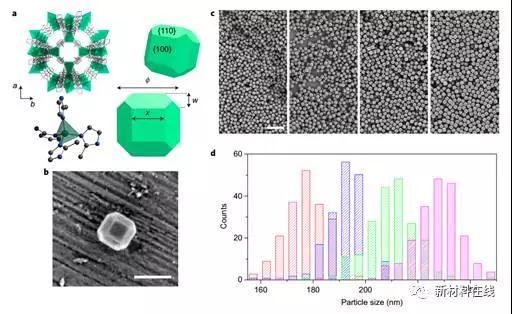
 2. Tunable porous nanoallotropes prepared by post-assembly etching of binary nanoparticle superlattices. There are hundreds of different colloidal crystals that can be used. Nanoparticles are prepared by self-assembly, but are almost always limited to having to be densely packed. Udayabhaskararao demonstrates that non-closely packed arrays of nanoparticles can be fabricated by selectively removing one of the two components that make up the binary nanoparticle superlattice. First, a variety of binary nanoparticle superlattices were prepared at the liquid-air interface, including several previously unknown. Molecular dynamics simulations reveal the special role of liquids in the formation of superlattices in the template. Superlattices cannot be achieved by self-assembly in bulk solutions. Second, after stabilization, all of these binary superlattices can be converted into nanoporous materials that have the same chemical composition but differ from their nanoscale structures, ie, "nano allotropes." (Science DOI: 10.1126/science.aan6046)
2. Tunable porous nanoallotropes prepared by post-assembly etching of binary nanoparticle superlattices. There are hundreds of different colloidal crystals that can be used. Nanoparticles are prepared by self-assembly, but are almost always limited to having to be densely packed. Udayabhaskararao demonstrates that non-closely packed arrays of nanoparticles can be fabricated by selectively removing one of the two components that make up the binary nanoparticle superlattice. First, a variety of binary nanoparticle superlattices were prepared at the liquid-air interface, including several previously unknown. Molecular dynamics simulations reveal the special role of liquids in the formation of superlattices in the template. Superlattices cannot be achieved by self-assembly in bulk solutions. Second, after stabilization, all of these binary superlattices can be converted into nanoporous materials that have the same chemical composition but differ from their nanoscale structures, ie, "nano allotropes." (Science DOI: 10.1126/science.aan6046)  3. Size effects in ion transport through angstrom-scale slits. In the field of nanofluids, it is a far cry to controllably produce capillaries close to the size of small ions and water molecules. final goal. Esfandiar et al. describe ion transport through extremely narrow slits that are fabricated by effectively removing monoatomic planes from bulk crystals. This atomic-scale flat angstrom gap exhibits a very low surface charge and can be explained by the steric effect. Esfandiar et al. also found that ions with a hydration diameter larger than the slit size are still permeable despite the reduced fluidity. The limitation of the slit also allows a comparable size of anion and cation to exhibit a significantly asymmetric migration rate in the channel. This research provides a platform for studying the Ei-scale constraint effects necessary for the development of nanofluids, molecular separations, and other nanotechnology. (Science DOI: 10.1126/science.aan5275)
3. Size effects in ion transport through angstrom-scale slits. In the field of nanofluids, it is a far cry to controllably produce capillaries close to the size of small ions and water molecules. final goal. Esfandiar et al. describe ion transport through extremely narrow slits that are fabricated by effectively removing monoatomic planes from bulk crystals. This atomic-scale flat angstrom gap exhibits a very low surface charge and can be explained by the steric effect. Esfandiar et al. also found that ions with a hydration diameter larger than the slit size are still permeable despite the reduced fluidity. The limitation of the slit also allows a comparable size of anion and cation to exhibit a significantly asymmetric migration rate in the channel. This research provides a platform for studying the Ei-scale constraint effects necessary for the development of nanofluids, molecular separations, and other nanotechnology. (Science DOI: 10.1126/science.aan5275)  4. One of the current challenges of photonics based on MoTe2-based light-emitting diodes and photodetectors for silicon photonic integrated circuits is the development of high-speed, high-power, chip-integrated optical communication devices. To solve the interconnection bottleneck in high-speed computing systems. Silicon photonics has emerged as the leading architecture, in part because many components such as waveguides, couplers, interferometers, and modulators can be directly integrated into silicon-based processors. However, light sources and photodetectors are facing challenges. Common methods for use as light sources include one or several off-chip or wafer-bonded lasers based on Group III-V materials, but recent system architecture studies have shown the advantage of using multiple directly modulated sources at the emitter location. The most advanced photodetectors in the silicon photonics process are based on germanium, but this requires additional growth of germanium, which increases system cost. The emerging two-dimensional transition metal disulfide (TMD) provides a way for optical interconnect devices to be integrated with silicon photonics and complementary metal oxide semiconductors (CMOS) through back-end processing. Bie et al. demonstrated a silicon waveguide integrated source and photodetector (TMD semiconductor with infrared band) based on a two-layer MoTe2-doped pn junction. This state-of-the-art manufacturing technology offers new opportunities for integrated photovoltaic systems. (Nature Nanotechnology DOI: 10.1038/NNANO.2017.209)
4. One of the current challenges of photonics based on MoTe2-based light-emitting diodes and photodetectors for silicon photonic integrated circuits is the development of high-speed, high-power, chip-integrated optical communication devices. To solve the interconnection bottleneck in high-speed computing systems. Silicon photonics has emerged as the leading architecture, in part because many components such as waveguides, couplers, interferometers, and modulators can be directly integrated into silicon-based processors. However, light sources and photodetectors are facing challenges. Common methods for use as light sources include one or several off-chip or wafer-bonded lasers based on Group III-V materials, but recent system architecture studies have shown the advantage of using multiple directly modulated sources at the emitter location. The most advanced photodetectors in the silicon photonics process are based on germanium, but this requires additional growth of germanium, which increases system cost. The emerging two-dimensional transition metal disulfide (TMD) provides a way for optical interconnect devices to be integrated with silicon photonics and complementary metal oxide semiconductors (CMOS) through back-end processing. Bie et al. demonstrated a silicon waveguide integrated source and photodetector (TMD semiconductor with infrared band) based on a two-layer MoTe2-doped pn junction. This state-of-the-art manufacturing technology offers new opportunities for integrated photovoltaic systems. (Nature Nanotechnology DOI: 10.1038/NNANO.2017.209) 
5. Toughening elastomers using mussel-inspired iron-catechol complexes often exhibit a compromise between stiffness and ductility; for example, by increasing Its crosslink density to enhance the elastomer leads to embrittlement and reduced toughness. Inspired by the marine mussels byssi epidermis, Filippidi et al. circumvent this inherent trade-off by linking sacrificial reversible iron-catechol crosslinks to a dry, loosely crosslinked epoxy network. The stiffness, tensile strength and tensile toughness of the iron-containing network are increased by two to three orders of magnitude compared to their iron-free precursors, while achieving recoverable hysteresis energy dissipation and maintaining their original scalability. The drying properties of the iron-containing network itself result in improved performance compared to previous chemical experiments in hydrogels, mainly due to the enhanced crosslink density provided by the reversible iron-catechol complexes and their formation. The synergistic effect of the ionomer clusters of the chain is restricted. (Science DOI: 10.1126/science.aao0350)
 6. Topological states of condensed matter The topological state of quantum matter has been studied intensively in materials science and condensed matter physics in recent years. The explosive development of this field is largely due to accurate theoretical predictions, enabling well-controlled material processing and emerging characterization techniques. In this Perspective article, Wang et al. reviewed recent advances in topological insulators, quantum anomalous Hall effects, chiral topological superconductors, spiral topological superconductors, and Weyl semimetals. (Nature Materials DOI: 10.1038/NMAT5012)
6. Topological states of condensed matter The topological state of quantum matter has been studied intensively in materials science and condensed matter physics in recent years. The explosive development of this field is largely due to accurate theoretical predictions, enabling well-controlled material processing and emerging characterization techniques. In this Perspective article, Wang et al. reviewed recent advances in topological insulators, quantum anomalous Hall effects, chiral topological superconductors, spiral topological superconductors, and Weyl semimetals. (Nature Materials DOI: 10.1038/NMAT5012)  7. Towards properties on demand in quantum materials Over the past decade, the explosive growth in the field of quantum materials has been strongly predicted and discovered by the novel symmetry breaking phase in related electronic systems. Topological phase in a system of rotating orbital coupling, and a super-steerable material platform based on two-dimensional van der Waals crystals. It is found that the way to realize the quantum phase of matter and control its properties through experiments is the core goal of modern condensed matter physics. To achieve this goal, it is hopeful to realize a new generation of electronic/photonic devices that cannot be realized at present and may not be able to imagine its function. In this review, Basov et al. describe an emerging strategy for selectively perturbing microscopic interaction parameters that can be used to transform materials into desired quantum states. The following discussion focuses on the recent success of customizing electronic interaction parameters through the use of strong fields, pulsed electromagnetic stimulation, and nanostructure engineering or interface engineering. Together, these methods outline a potential roadmap for the age of quantum phenomena. (Nature Materials DOI: 10.1038/NMAT5017)
7. Towards properties on demand in quantum materials Over the past decade, the explosive growth in the field of quantum materials has been strongly predicted and discovered by the novel symmetry breaking phase in related electronic systems. Topological phase in a system of rotating orbital coupling, and a super-steerable material platform based on two-dimensional van der Waals crystals. It is found that the way to realize the quantum phase of matter and control its properties through experiments is the core goal of modern condensed matter physics. To achieve this goal, it is hopeful to realize a new generation of electronic/photonic devices that cannot be realized at present and may not be able to imagine its function. In this review, Basov et al. describe an emerging strategy for selectively perturbing microscopic interaction parameters that can be used to transform materials into desired quantum states. The following discussion focuses on the recent success of customizing electronic interaction parameters through the use of strong fields, pulsed electromagnetic stimulation, and nanostructure engineering or interface engineering. Together, these methods outline a potential roadmap for the age of quantum phenomena. (Nature Materials DOI: 10.1038/NMAT5017)  8. Self-assembly of polyhedral metal-organic framework particles into three-dimensional ordered superstructures. Self-assembly of particles into a city, three-dimensional, ordered superstructure for design Materials (including plasma sensing materials, energy or gas storage systems, catalysts, and photonic crystals) are critical. Avci et al., based on experimental and simulation data, show that the metal-organic framework (MOF) ZIF-8 truncated rhombohedral dodecahedral particles can self-assemble into millimeter-sized superstructures with a basic three-dimensional diamond lattice that behaves as a photonic crystal. . These superstructures have a photonic band gap that can be adjusted by controlling the size of the ZIF-8 particles, or the guest material adsorbed in the micropores. Alternatively, superstructures with different crystal lattices can be assembled by adjusting the degree of truncation of ZIF-8 nanoparticles or using octahedral Uio-66 MOF particles. These ordered sub-micron sized superstructure materials may ultimately contribute to the design of three-dimensional photonic materials for sensing applications. (Nature Chemistry DOI: 10.1038/NCHEM.2875)
8. Self-assembly of polyhedral metal-organic framework particles into three-dimensional ordered superstructures. Self-assembly of particles into a city, three-dimensional, ordered superstructure for design Materials (including plasma sensing materials, energy or gas storage systems, catalysts, and photonic crystals) are critical. Avci et al., based on experimental and simulation data, show that the metal-organic framework (MOF) ZIF-8 truncated rhombohedral dodecahedral particles can self-assemble into millimeter-sized superstructures with a basic three-dimensional diamond lattice that behaves as a photonic crystal. . These superstructures have a photonic band gap that can be adjusted by controlling the size of the ZIF-8 particles, or the guest material adsorbed in the micropores. Alternatively, superstructures with different crystal lattices can be assembled by adjusting the degree of truncation of ZIF-8 nanoparticles or using octahedral Uio-66 MOF particles. These ordered sub-micron sized superstructure materials may ultimately contribute to the design of three-dimensional photonic materials for sensing applications. (Nature Chemistry DOI: 10.1038/NCHEM.2875) 
Gift Bags,Gift Bag Hiking Travel Pack,Eco Gift Bag,Gift String Bag
Dongguan C.Y. RedApple Industrial Limited , https://www.zjhpgbags.com
